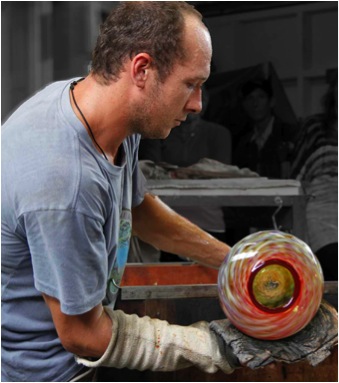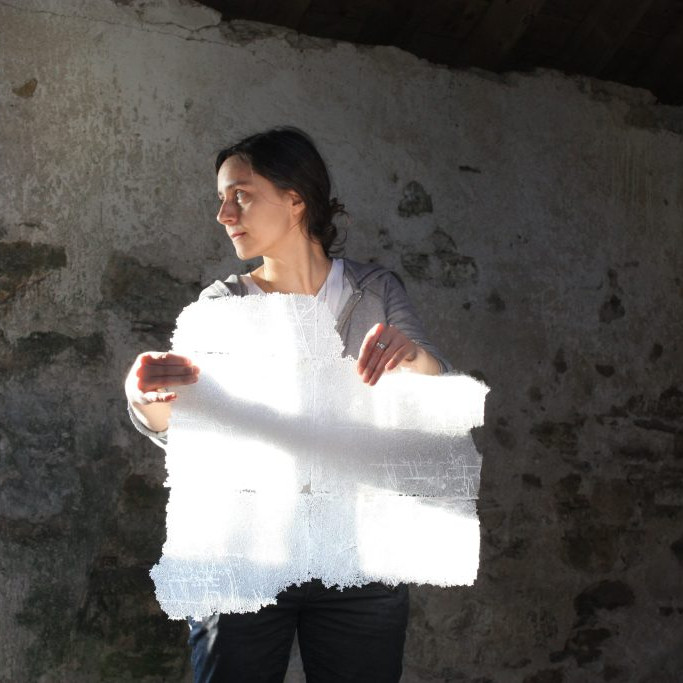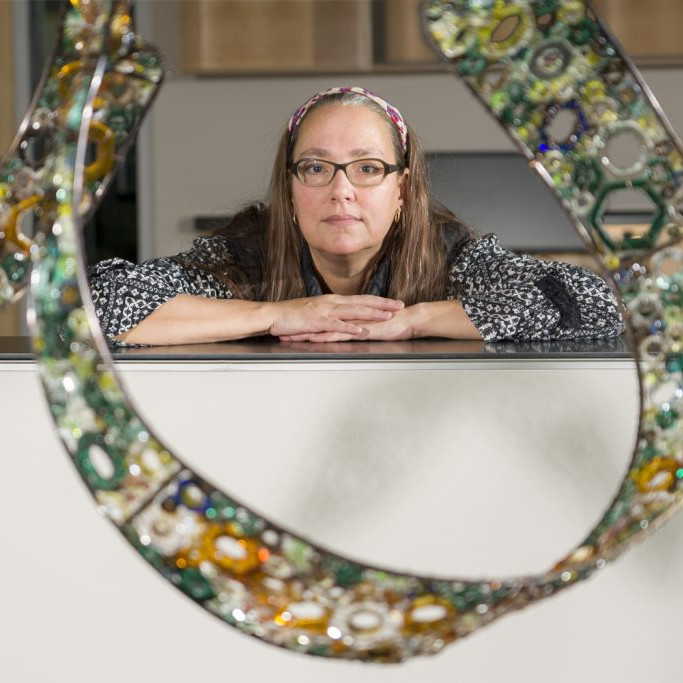Justin Culina Glass Artist - Whangarei, New Zealand
Can you explain the technique/s you use for your glass making?
I use traditional glass blowing techniques which have been used for centuries.
Glass blowing techniques have not changed much in the last 2000 years, I create my own unique take on these through the use of colour and form.
As I am largely self-taught I have my own adaptations and interpretations of age old techniques like cane roll ups, murine, incalmo, filigree, latticino.
The process of achieving and sustaining the high temperatures required to blow glass has been refined to the point where it is now possible for one person to run a hot shop; whereas it used to be necessary to work as a large team.
Colour is a huge part of your work, please expand on this?
I tend to prefer the use of transparent rather than opaque colours because of the way the light transmits through the glass. I sometimes even find myself blowing opaque colours until they are translucent. I am generally attracted to cooler tone colours however I find myself constantly experimenting with a new colour and the way it reacts with glass. Each colour has its own unique properties
I am fascinated by the chemistry of colour in glass work and the many ways you can manipulate colour through chemical reactions and heat exposure.
Where do you get your inspiration from?
The glass blowing process is quite inspiring on its own,I also take daily inspiration from my natural surroundings. I live in a beautiful spot with the ocean, bush and wildlife on my doorstep.
Colour
The way colours combine harmoniously together in nature fascinates me. I love the way the coloured glass plays with the light and almost any colour can be appealing used in the right way.
Form
Molten glass, being so liquid, allows for fluid forms to be created. The smallest changes in shape can change the look of the overall piece dramatically.
I feel I am in partnership with the glass allowing it to have a say in the final form.
Clean lines are very important in my work.
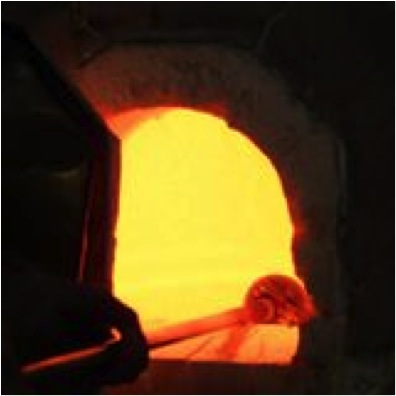
How did getting your own hot glass studio affect your work and output?
Five years ago I started Culina Glass, which has changed my focus from ‘glass blower’ to ‘glass blower/business owner’. I have had to diversify my range to incorporate high end one off pieces and to put more emphasis on production work.
A hotshop’s running costs are very high. To keep costs down I have built much of my own equipment. This has broadened my knowledge of hot glass equipment function, and maintenance. It has also allowed me to customize my equipment to best suit my needs.
Owning a hot glass studio and being in the studio everyday has given me more time with the glass, so my learning has progressed more quickly and I have pursued more design options.
Having my own hot glass studio has changed my life.
Are people encouraged to visit your studio?
My hot shop is in a rural setting and therefore has very little through traffic. However 2 or 3 times a year I have an open studio weekend, showing my new work, glass blowing demonstrations, refreshments and studio sales. These are very profitable and well attended and it is always fun and gratifying to share my craft and workspace with the interested public. I also welcome visits by appointment at any time.
Take us into Culina Glass and show us around explaining the equipment and other specific spaces you need?
The heart of Culina Glass is the furnace which is the kiln I use to melt sand into clear glass, the material I use to make all my work. It runs between 1100degrees C and 1300 degrees C 24 hours a day. Arranged around the furnace is the pipe warmer, large and small glory holes, toaster oven, pick up kiln, annealing kiln, marvers, glass blowers bench, torches, assorted hand tools, and coloured glass rods.
In the next room is the cold working equipment which includes a flat bed grinder (for polishing the bottom of the pieces to make them sit dead flat), a vat of acid etch for achieving a satin finish on my work. A dremmel tool for signing the work. My coldworking equipment is minimal as I prefer to complete the pieces as much as possible in their hot stage.
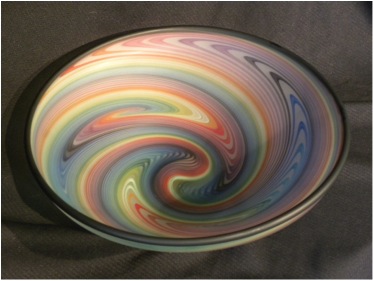
I also have a lampworking area for jewellery and smaller components.
In the final room is a small gallery space where the finished work is on display. Before shipping, I photograph each piece.
Music is also a very important part of my work environment.
Can you explain safety issues around your art?
Working in a hotshop can be dangerous and toxic to one’s health if precautions are not taken. Everyday risks include: heat exhaustion, deterioration of vision, lacerations, burns, high toxicity levels, and potential inhalation of particulate matter. However my hotshop is safe as!
If proper safety precautions are observed (such as use of respirators, proper ventilation, didydium glasses, heat shields, a clean shop) and a sensible work schedule is maintained a hot shop can be a fun and safe place to work.
Do you work with others in the studio?
I have some processes which require two people and I employ an assistant on these occasions. Generally I work by myself.
Sometimes I have New Zealand and international glass blowers come to rent the hot shop and I try to always make time to create some pieces with them while they are here. We share our love of glass and learn from one another.
It’s a bit like dancing with someone else instead of by yourself.
Are exhibitions an important part of your diary or do you just send small amounts to many galleries?
I enjoy exhibiting, especially the feedback I get. I stock many galleries and would like to participate in more exhibitions.
Take three pieces and discuss them.
Incalmo Vase
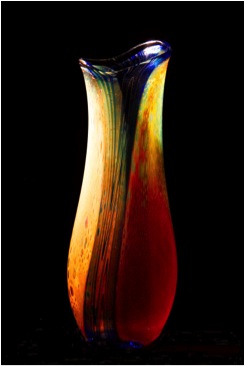
The Incalmo technique is the process of joining two or more glass cups that have been individually designed to create a vase with strong definition between colours and patterns.
I use a variety of contrasting colors for the Incalmo vases.
Though the design is complex the completed vase has a very fluid organic shape.
It is a vase which is functional but mainly used as a decorative piece of art.
Roll-up bowl
This is an old Italian technique of rolling up fused canes of glass to create a linear design to the piece.
I make these roll up bowls in a range of colours. Two distinctive colour schemes I have been using are the colours of the rainbow and my ‘Pacific Rim’ range which features bold black red and white.
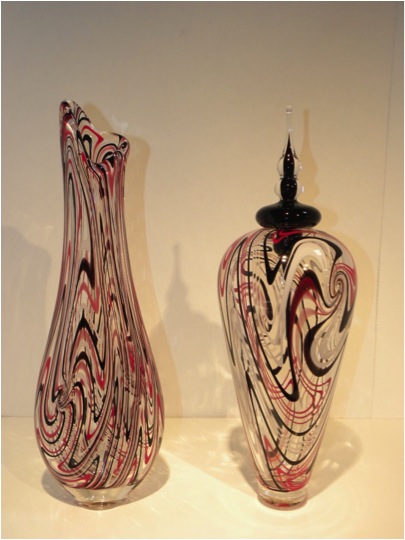
The form of this style of bowl varies from a deep rounded bowl to a nearly flat platter shape. These are functional pieces and I encourage people to use them.
Spirit Vase
A Spirit Vase is a simple coloured blown glass bubble with a stopper which is made separately.
I make spirit vases in every colour of the rainbow.
In concept of form but not actual form the spirit vases represent people in their variety of shapes and sizes. The spirit vases are as diverse and individual as the people of our world and I like to illustrate this by grouping the contrasting forms together.
These are conceptual pieces. I like to think they inspire people to enjoy the diversity of our surroundings.
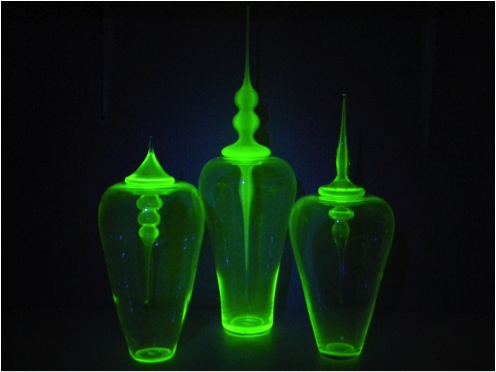
How important is it to have your pieces functional?
Function is not necessarily a requirement in my work.
However, I do enjoy making functional work as glass is such a beautiful medium to make useful things out of. I enjoy the challenge of mastering age old glass blowing techniques, for example the process of making a goblet has been perfected over thousands of years and yet every hand blown piece is still individual. My respect for the traditional methods and designs inspires me to try to create my own unique take on them.
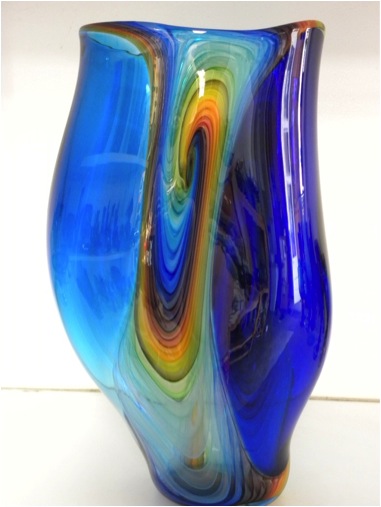
Packaging, can you discuss this?
As I courier my work throughout the country and overseas, packaging is an important issue for me. I have always used cardboard boxes, large quantities of recycled newspaper and recycled bubble wrap to pack my work for shipping. Over the years I have only lost a handful of pieces.
Can you explain how your glass should be cared for after purchase?
Glass should not be cleaned with any abrasive material, as it could scratch the glazed surface. It should not be heated or cooled abruptly as thermal shock could occur, causing cracks. Glass will last many centuries, if well looked after.
Can you discuss pattern in your work?
The patterns I tend to focus on in my work are dictated by the processes I use to create them. For example, when canes are used the piece has a linear colour pattern and if I use frit colour the colour placement is random.
How large can you make your pieces or what restrictions do you place on size?
The size of my work is limited by my personal abilities, my chi on the day and the diameter and height of my equipment. Weight becomes a huge factor when working on my own. Five kg of weight is a lot of weight to manipulate on the end of a 4’ blow pipe.
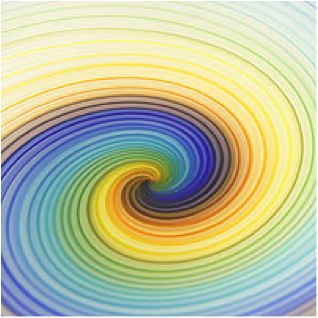
Contact details.
Email: culinaglass@clear.net.nz
Address: 167 Te Rongo Road, Whangarei, Northland 0148
Justin Culina, Whangarei, New Zealand,
Interview by Deborah Blakeley, June, 2013
Think a colleague or friend could benefit from this interview?
Knowledge is one of the biggest assets in any business. So why not forward this on to your friends and colleagues so they too can start taking advantage of the insightful information the artist has given?
Other artists you may be interested in:


